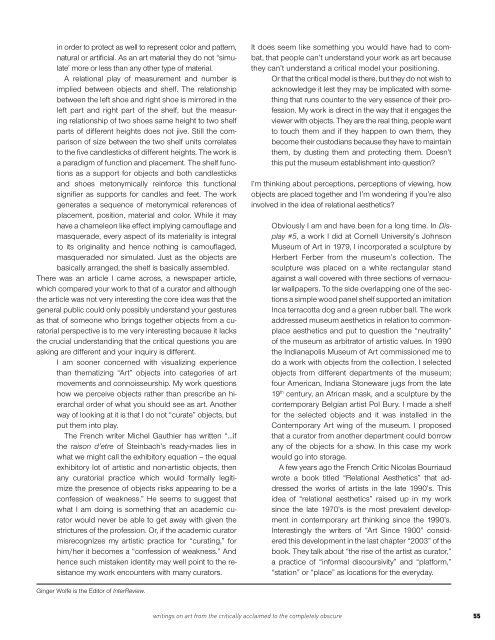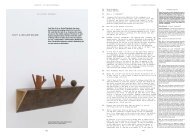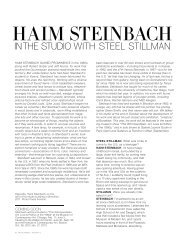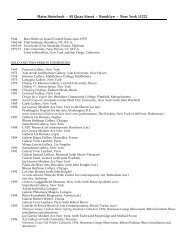Ginger Wolfe Interviews Haim Steinbach
Ginger Wolfe Interviews Haim Steinbach
Ginger Wolfe Interviews Haim Steinbach
You also want an ePaper? Increase the reach of your titles
YUMPU automatically turns print PDFs into web optimized ePapers that Google loves.
in order to protect as well to represent color and pattern,<br />
natural or artificial. As an art material they do not “simulate’<br />
more or less than any other type of material.<br />
A relational play of measurement and number is<br />
implied between objects and shelf. The relationship<br />
between the left shoe and right shoe is mirrored in the<br />
left part and right part of the shelf, but the measuring<br />
relationship of two shoes same height to two shelf<br />
parts of different heights does not jive. Still the comparison<br />
of size between the two shelf units correlates<br />
to the five candlesticks of different heights. The work is<br />
a paradigm of function and placement. The shelf functions<br />
as a support for objects and both candlesticks<br />
and shoes metonymically reinforce this functional<br />
signifier as supports for candles and feet. The work<br />
generates a sequence of metonymical references of<br />
placement, position, material and color. While it may<br />
have a chameleon like effect implying camouflage and<br />
masquerade, every aspect of its materiality is integral<br />
to its originality and hence nothing is camouflaged,<br />
masqueraded nor simulated. Just as the objects are<br />
basically arranged, the shelf is basically assembled.<br />
There was an article I came across, a newspaper article,<br />
which compared your work to that of a curator and although<br />
the article was not very interesting the core idea was that the<br />
general public could only possibly understand your gestures<br />
as that of someone who brings together objects from a curatorial<br />
perspective is to me very interesting because it lacks<br />
the crucial understanding that the critical questions you are<br />
asking are different and your inquiry is different.<br />
I am sooner concerned with visualizing experience<br />
than thematizing “Art” objects into categories of art<br />
movements and connoisseurship. My work questions<br />
how we perceive objects rather than prescribe an hierarchal<br />
order of what you should see as art. Another<br />
way of looking at it is that I do not “curate” objects, but<br />
put them into play.<br />
The French writer Michel Gauthier has written “…if<br />
the raison d’etre of <strong>Steinbach</strong>’s ready-mades lies in<br />
what we might call the exhibitory equation – the equal<br />
exhibitory lot of artistic and non-artistic objects, then<br />
any curatorial practice which would formally legitimize<br />
the presence of objects risks appearing to be a<br />
confession of weakness.” He seems to suggest that<br />
what I am doing is something that an academic curator<br />
would never be able to get away with given the<br />
strictures of the profession. Or, if the academic curator<br />
misrecognizes my artistic practice for “curating,” for<br />
him/her it becomes a “confession of weakness.” And<br />
hence such mistaken identity may well point to the resistance<br />
my work encounters with many curators.<br />
<strong>Ginger</strong> <strong>Wolfe</strong> is the Editor of InterReview.<br />
writings on art from the critically acclaimed to the completely obscure<br />
It does seem like something you would have had to combat,<br />
that people can’t understand your work as art because<br />
they can’t understand a critical model your positioning.<br />
Or that the critical model is there, but they do not wish to<br />
acknowledge it lest they may be implicated with something<br />
that runs counter to the very essence of their profession.<br />
My work is direct in the way that it engages the<br />
viewer with objects. They are the real thing, people want<br />
to touch them and if they happen to own them, they<br />
become their custodians because they have to maintain<br />
them, by dusting them and protecting them. Doesn’t<br />
this put the museum establishment into question?<br />
I’m thinking about perceptions, perceptions of viewing, how<br />
objects are placed together and I’m wondering if you’re also<br />
involved in the idea of relational aesthetics?<br />
Obviously I am and have been for a long time. In Display<br />
#5, a work I did at Cornell University’s Johnson<br />
Museum of Art in 1979, I incorporated a sculpture by<br />
Herbert Ferber from the museum’s collection. The<br />
sculpture was placed on a white rectangular stand<br />
against a wall covered with three sections of vernacular<br />
wallpapers. To the side overlapping one of the sections<br />
a simple wood panel shelf supported an imitation<br />
Inca terracotta dog and a green rubber ball. The work<br />
addressed museum aesthetics in relation to commonplace<br />
aesthetics and put to question the “neutrality”<br />
of the museum as arbitrator of artistic values. In 1990<br />
the Indianapolis Museum of Art commissioned me to<br />
do a work with objects from the collection. I selected<br />
objects from different departments of the museum;<br />
four American, Indiana Stoneware jugs from the late<br />
19 th century, an African mask, and a sculpture by the<br />
contemporary Belgian artist Pol Bury. I made a shelf<br />
for the selected objects and it was installed in the<br />
Contemporary Art wing of the museum. I proposed<br />
that a curator from another department could borrow<br />
any of the objects for a show. In this case my work<br />
would go into storage.<br />
A few years ago the French Critic Nicolas Bourriaud<br />
wrote a book titled “Relational Aesthetics” that addressed<br />
the works of artists in the late 1990’s. This<br />
idea of “relational aesthetics” raised up in my work<br />
since the late 1970’s is the most prevalent development<br />
in contemporary art thinking since the 1990’s.<br />
Interestingly the writers of “Art Since 1900” considered<br />
this development in the last chapter “2003” of the<br />
book. They talk about “the rise of the artist as curator,”<br />
a practice of “informal discoursivity” and “platform,”<br />
“station” or “place” as locations for the everyday.<br />
55





